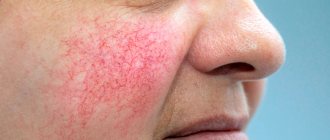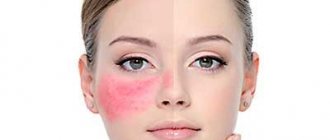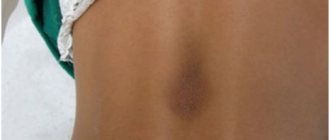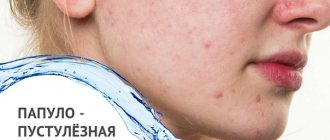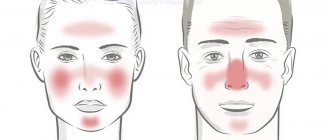Symptoms of rosacea
The clinical manifestations of the disease differ depending on its form. But in most cases, rosacea is accompanied by the following symptoms:
- Erythema. Redness of the skin in the central part of the face. Initially, it is episodic in nature, but over time the frequency of occurrence increases. The shade can vary from bright pink to bluish.
- Increased dryness of the skin, excessive sensitivity to touch. In some cases, mild pain or a tingling sensation may occur.
- Telangiectasia. The so-called spider veins. They are dilated capillary vessels that look like small spots and nets of pink or red color. Most often located around the wings of the nose.
- Papules. Dense skin nodules that rise slightly above the surrounding skin. The color is flesh or pale pink. When there are large numbers, they can merge into one common bumpy surface.
- Pustules. Small bubbles filled with clear or slightly cloudy liquid. Formed in place of papules.
- Structural changes in the skin. Initially, swelling of the affected areas occurs, which can subsequently be combined with hyperplasia (thickening) of the skin. In some cases, large structural formations form that distort facial features.
- Eye lesions. Redness of the mucous membranes, often combined with itching and a feeling of “sand” in the eyes. In severe cases, crusts appear at the roots of the eyelashes, and visual acuity decreases.
Erythema with rosacea.
Photo: Head & face medicine / Open-i (CC BY 2.0) Rosacea is characterized by periods of exacerbations and remissions. During exacerbations, new elements of the rash (papules, pustules) appear. When going into remission, the rash often disappears, but skin erythema, telangiectasia and structural changes in the facial skin persist.
Removal of spider veins and visible vessels on the face. (Photocoagulation, photorejuvenation)
Spider veins on the cheeks, nose, red cheeks, purple face - all this is characteristic of the disease rosacea, its first manifestations are often called rosacea. This is a constitutional feature, it does not affect our well-being in any way, but it is of great importance in the perception of the people around us.
There are many options for camouflage, prevention, lifestyle rules, skincare cosmetics that slow down the process, but few techniques can remove dilated blood vessels that have already appeared on the face.
One of the most effective is a hardware procedure using IPL systems, also called photocoagulation or photorejuvenation. This can be done by a cosmetologist in his office. The processing area depends on the area of the process. Of course, what you won’t leave the consultation without is the wise advice of a cosmetologist
CLICK on one photo to view the entire photo gallery
Rosacea treatment
Since rosacea is currently an incurable pathology, the main goals of therapy are:
- Suppressing existing symptoms and improving the overall condition of the skin.
- Slowing down further progression of the disease.
- Prevention of repeated exacerbations and complications.
- Elimination or minimization of cosmetic defects.
To achieve these goals, various means are used: drug therapy, physiotherapy, and, if necessary, surgery. Moreover, the effectiveness of treatment depends on the duration of the disease, the severity of the clinical form and the presence of concomitant pathologies.
How to care for facial skin with rosacea
Rosacea requires special skin care. It is based on the following principles:
- Cleansing the skin should be soft and gentle, without using hot water, as it dilates blood vessels.
- Vacuum massage, frequent peelings, and facial steaming are contraindicated.
- When choosing cosmetics, you should choose products without alcohol and detergents. In this case, you should give preference to products that contain components that strengthen the vascular wall: vitamins K, P, C, ambophenol.
- When staying in the sun or in the cold, be sure to use a protective cream, and then a nourishing one.
- When washing off cosmetics, it is better to give preference to clean water.
Drug therapy
The leading place in the treatment of rosacea is occupied by medications. Most often, the therapeutic regimen includes:
- Systemic antibiotics. For oral administration, tetracyclines (doxycycline, tetracycline), macrolides (azithromycin, clarithromycin), and antimicrobial agents (metronidazole) are prescribed.
- Systemic retinoids. Drugs in this group are structural analogues of vitamin A. Their use is recommended for severe rosacea (in modern clinical practice, isotretinoin is most often used).
- Local therapy. For application directly to the affected areas of the skin, metronidazole, azelaic acid, sodium sulfacetamide, and clindamycin are prescribed.
- Angioprotectors. To improve the condition of blood vessels, xanthinol nicotinate, belladonna alkaloids, and ergotamine are used.
- Additional funds. For ophthalmic rosacea, artificial tears may also be prescribed. After eliminating the active inflammatory process, brimonidine therapy is possible to combat erythema.
Physiotherapeutic procedures
Physiotherapy is an important part of complex treatment, complementing the effect of medications. For rosacea, the following procedures are most often prescribed:
- Cryotherapy and cryomassage.
- Electrocoagulation.
- Laser therapy.
- Selective pulsed phototherapy.
- Microcurrent therapy.
- Endonasal electrophoresis.
- Dermabrasion.
Surgery
When excess tissue forms on the face (for example, with phymatous and granulation variants of rosacea), its removal is indicated. This can be done in various ways: ablative lasers (CO² lasers or erbium YAG laser), cryosurgery, plastic surgery, electrocoagulation, etc.
Rosacea: before and after treatment. Photo: American Academy of Dermatology / ResearchGate (Creative Commons Attribution-NonCommercial-NoDerivatives 4.0 International)
Acne vulgaris (acne)
Acne vulgaris usually occurs between the ages of 14 and 25, while rosacea occurs between 30 and 50 years. It is also necessary to carry out a differential diagnosis with late acne .
Common manifestations with late acne
Appearance after 40 years
Papulopustular skin rashes
Overproduction of sebum – oily skin
Possibly - prolonged exposure to the sun - a common “trigger”
Differential diagnosis
Criteria not typical for acne are diagnostic for rosacea:
Centrofascial erythema is redness of the central part of the face, which may be accompanied by subjective sensations of itching, burning or tingling. A must-have for rosacea!
Outbreaks of erythema - occur when nerve endings are irritated by provoking factors: stress, heat exposure, drinking hot and alcoholic drinks, etc.
Couperosis – appearance on the face, because the disease affects the vascular bed.
No comedones!
Anamnesis
An important part of any consultation. If the rash was present at a young age, the development of late acne is most likely.
Causes of the disease
At the moment, the exact causes of rosacea have not been established.
It is believed that from 15% to 40% of all cases of the disease are associated with a hereditary tendency to this pathology.
A number of factors lead to the development of rosacea, among which the following play the most important role:
- Violation of vascular tone. This is often manifested by migraines and a tendency to spontaneous redness of the face (transient hyperemia).
- Lymphostasis, lymph stagnation. Accompanied by tissue swelling.
- Hormonal imbalance. The cause of rosacea can be both physiological fluctuations in hormones in the body (changes in the menstrual cycle, pregnancy, transition to menopause) and endocrine diseases, such as pathologies of the thyroid gland.
- Skin diseases. Rosacea is associated with disruption of the sebaceous and sweat glands, including seborrhea. Its development can also be provoked by demodicosis (infection of the skin with parasitic mites - Demodex folliculorum).
- Diseases of the gastrointestinal tract and digestive disorders. Triggering factors can be Helicobacter pylori infection, gastritis, duodenitis, colitis. Errors in nutrition also play an important role, including excessive consumption of spicy and fried foods.
- Stress. There is an opinion that nervous overstrain can trigger the onset of the disease.
- Immune system dysfunction: HIV infection, AIDS, diabetes mellitus.
- Excessive exposure to ultraviolet rays. Skin lesions can be associated with excessive tanning and sunburn, and abuse of solariums.
- Occupational hazards. In some cases, the trigger (trigger factor) may be working conditions: working in the open air, in cold or hot weather, in strong winds. Rosacea can also develop when the skin comes into contact with chemicals used in manufacturing.
- Side effects of medications. Rosacea can occur as a reaction to medications (often bromine and iodine derivatives). It is also associated with long-term, uncontrolled use of oral or topical hormonal drugs, such as oral contraceptives or corticosteroid ointments.
- Incorrect use of cosmetics. A trigger for rosacea can be the application of low-quality cosmetics to the skin of the face, which contain chemical irritants.
Patients with rosacea often suffer from nervous system disorders. Photo: wirestock/freepik.com
Risk factors
In addition to disorders that can directly cause the development of rosacea, it is worth mentioning factors that do not independently provoke the disease, but increase the risk of its occurrence. These include³:
- Female. Women are more likely to develop rosacea than men.
- Fair skin, especially those with high sensitivity to the sun. This is manifested by frequent sunburn even after short periods of exposure to direct sunlight.
- Age over 30 years.
- Smoking.
- The presence of rosacea in close blood relatives.
Complications of rosacea
Rosacea can lead to various complications, both infectious and cosmetic. The most common are:
- Purulent-septic complications. This includes all types of skin lesions associated with secondary infection, most often with pathogenic bacteria. One of these is the draining sinus. It is a long-term, sluggish inflammation, accompanied by the formation of an oval skin formation, from which purulent masses are constantly released.
- Eye lesions. Long-lasting inflammatory reactions of the tissues of the eye and eyelid against the background of ophthalmic rosacea can lead to deterioration of vision. In severe cases, even its complete loss - blindness - is possible.
- Gross cosmetic defects. Long-term course of rosacea, especially with its phymatous and granulomatous variants, often leads to deformation of parts of the face (nose, ears, chin). This significantly reduces a person’s quality of life and can also become a trigger for depressive disorders.
Coffee can worsen rosacea symptoms. Photo: valeria_aksakova / freepik.com
Diagnosis of rosacea
Diagnosis is based on the patient’s complaints, medical history (course of the disease, provoking factors, concomitant pathologies, presence of risk factors) and physical examination. Laboratory and instrumental research methods can be used as auxiliary means.
In most cases, the diagnosis is established after examining the skin by a dermatologist, including using dermatoscopy. A distinctive feature of rosacea is persistent redness of the central area of the face with intact areas around the eyes, which persists for at least 3 months.
In order to differentiate with other diseases and clarify the existing form of rosacea, the following additional diagnostic methods can be used:
- Microscopic examination of skin scrapings to identify Demodex folliculorum mites.
- Bacteriological examination of the contents of pustules to detect secondary infection.
- Routine blood and urine tests, supplemented by tests for markers of systemic connective tissue diseases.
- Dopplerography. Allows you to study microcirculation in the vessels of the facial skin and identify the slowdown in blood flow characteristic of rosacea.
- Ultrasound examination (ultrasound) of the skin. It is used to determine the structure of skin formations and the thickness of skin layers.
- Confocal laser scanning microscopy. Allows you to assess the condition of the skin down to the reticular layer of the dermis without compromising its integrity. Due to this, you can obtain detailed information about regional vessels, cells of different layers of the skin, as well as study the degree of xerosis (dryness) and peeling, and the number of demodex mites.
Differential diagnosis of rosacea is carried out with other diseases that may have similar symptoms. These include:
- Seborrheic dermatitis.
- Discoid lupus erythematosus.
- Dermatomyositis.
- Randu-Osler syndrome.
- Perioral dermatitis.
- Acne vulgaris.
- Rubromycosis of the facial skin.
- Small nodular form of sarcoidosis.
- Tuberculous lupus.
- Erysipelas.
- Shingles.
- Angiosarcoma.
Wine stains on the face. Before and after
This is not the final result
Port-wine stains on the face and other open areas of the skin are very disturbing to owners. Some people get used to their presence over the years, while others come and remove them. Removing port-wine stains is not an easy task, but it is completely within the capabilities of both the patient and the doctor. This photo shows the result after 3 procedures and this is not the final result .
In addition to photo flashes on a device with an IPL system, special medications are prescribed for home care. The procedures are carried out at intervals of 3-5 weeks. Rehabilitation - redness and slight swelling of the treated area for 1 to 3 days.
Cosmetologist's work:
- Procedure interval 3-5 weeks
- Rehabilitation up to 3 days
- IPL system
- Not final result
Classification and forms of the disease
Rosacea is a chronic disease characterized by an undulating course with exacerbations and periods of remission. Nevertheless, several stages can be distinguished in the development of this pathology:
- Stage of transient erythema of the central part of the face. It is characterized by episodes of skin redness, which appears spontaneously and disappears without a trace.
- Stage of persistent (background) erythema and telangiectasia. At this stage, persistent redness of the facial skin and a specific skin rash occur. This is due to the expansion of local blood vessels.
- Papular stage. It manifests itself by the formation of papules against the background of existing hyperemia and telangiectasia.
- Pustular stage. It is characterized by the appearance of pustules with existing symptoms.
- Infiltrative-productive stage. Accompanied by swelling and fibrotic-hypertrophic changes in the skin.
Depending on the clinical characteristics, it is customary to distinguish the following main forms of pathology¹:
- Erythematous rosacea. It occurs with transient erythema, edema and telangiectasia. Over time, the redness of the facial skin becomes permanent.
- Papular and pustular rosacea. Variants of pathology in which, in addition to the main symptoms of the disease, papules and/or pustules appear.
- Phymatous rosacea. It is characterized by thickening of the skin, which causes characteristic lumpiness and pineal growths. Depending on the location of the growths, the following subtypes of pathology are distinguished: rhinophyma (nose area), metaphyma (forehead), gnathophyma (chin), otophima (ear), blepharophimosis (eyelids).
- Ophthalmic rosacea. Eye damage due to rosacea. Most often it includes blepharitis (inflammation of the eyelids) and conjunctivitis (inflammation of the mucous membrane of the eyes), less often – meibomitis (inflammation of the meibomian glands located along the edges of the eyelids) and recurrent chalazion. In severe cases, keratitis (inflammation of the cornea), scleritis (inflammation of the choroid of the eye - sclera) and iridocyclitis (inflammation of the iris and ciliary body) occur.
Less common are atypical variants of the disease, including the following clinical forms:
- Granulomatous rosacea. With this option, epithelioid cell granulomas form on the skin. Clinically, this is accompanied by the development of small dense papules, sometimes single nodes, which have a gray-yellow tint and leave behind scars.
- Conglobate rosacea. In addition to the main symptoms, there are nodular elements of a bluish-red or brownish-red color of a spherical shape, up to 1.5-2 cm in diameter, which are prone to suppuration.
- Halogen rosacea. Occurs when taking iodine and bromine. Clinically similar to the conglobate form.
- Steroid rosacea. Caused by long-term corticosteroid therapy. With this form, telangiectasia, atrophy and skin pigmentation often occur. The development of papular-pustular rashes due to collagen damage is also observed.
- Gram-negative rosacea. It is caused by uncontrolled use of antibiotics, mainly of the tetracycline series, due to which gram-negative flora joins the pathological process. Clinically manifested by the formation of small numerous pustules with bright yellow contents with a diameter of 2-3 mm and a red rim. Bluish-red or red-brown edematous papules, small nodules and cystic formations may also occur.
- Fulminant rosacea. It is characterized by the sudden development of the disease, in which, in addition to the main symptoms, papules and pustules appear, merging with each other into a large purulent conglomerate.
Clinical picture
. The following forms of rhinophyma are distinguished:
- fibrous-angiomatous;
- glandular;
- fibrous;
- actinic.
The fibrous-angiomatous form is characterized by uniform enlargement of the nose due to hypertrophy of the skin elements.
The nose does not lose its configuration and acquires a bright red color due to the abundance of blood vessels in this area. With the glandular form of rhinophyma, knobby formations form on the nose. Gradually they merge into large growths, nodes and bumps. The nose becomes deformed and disfigures the face. The nodes are soft to the touch, non-ulcerated, and have a bluish color. The sebaceous glands are enlarged and when pressure is applied to them, contents are released that have a very unpleasant odor.
The fibrous form is characterized by a bluish-violet color of the nose, many telangiectasias (vascular patterns of blue or red shades of various shapes, resulting from dilation of the blood vessels of the skin or mucous membrane). The sebaceous glands are hyperplastic (enlarged). The nose changes its shape and the skin becomes lumpy.
The actinic form is characterized by a uniform increase in the size of the nose. The color becomes brownish with a bluish tint. Telangiectasias (small red, pink or blue oblong spots on the skin filled with a network of small blood vessels visible under the skin) are located mainly on the wings of the nose. The pores are enlarged, purulent pimples, called pustules, are not observed.
Quite often, rhinophyma is accompanied by blepharitis (inflammation of the edges of the eyelids) and conjunctivitis (inflammation of the eye mucosa). This is due to inflammatory processes in the paranasal areas of the skin. Diagnostics. Instrumental research methods are not required to diagnose rhinophyma. Each form has its own characteristic features:
- fibrous-angiomatous form. Vasodilation and inflammation predominate.
- glandular form. There is severe hyperplasia of connective tissue and sebaceous glands, dilatation of blood vessels.
- fibrous form. It is based on a diffuse increase (hyperplasia) of connective tissue;
- actinic form. Increase in the number of elastic fibers.
Rhinophyma must be distinguished from reticulosarcomatosis (malignant tumor) and leprosy (leprosy).
Friends! Timely and correct treatment will ensure you a speedy recovery!
Prognosis and prevention
With timely treatment, the prognosis is relatively favorable: despite the fact that rosacea cannot be cured completely, achieving long-term remission is a completely feasible task. Exceptions are severe forms of the disease that are difficult to treat.
To prevent the occurrence of rosacea or the worsening of an existing pathology, you should follow these recommendations:
- Limit exposure to direct sunlight, high or low temperatures, and strong wind on the skin. If necessary, use a protective cream.
- Refuse to visit the bathhouse, sauna, solarium.
- Correct your diet by limiting the consumption of spicy foods, coffee, fatty and fried foods. You should also give up alcoholic beverages or at least reduce their consumption to a minimum.
- Avoid cosmetic procedures that involve strong mechanical or chemical effects on the facial skin (various peeling options, dermabrasion).
- Observe the rules of personal hygiene: use only individual towels, and when caring for your facial skin, give preference to disposable napkins.
- Use cosmetics without aggressive chemical components, use mild cleansers without irritating substances in their composition (menthol, alcohol, detergents).
- Avoid self-medication and uncontrolled use of medications. If rosacea is associated with drug therapy for another condition, you should consult your doctor.




